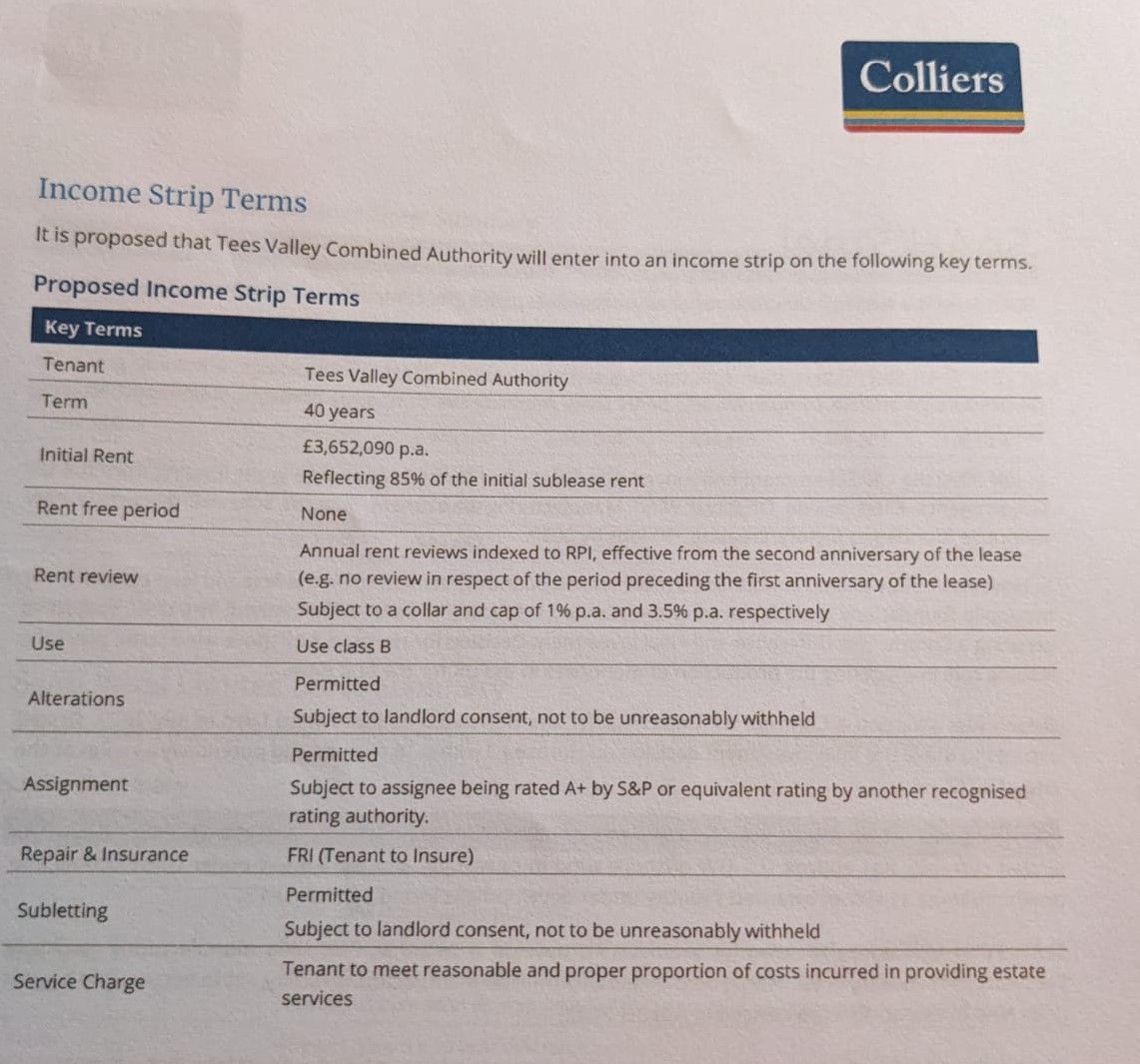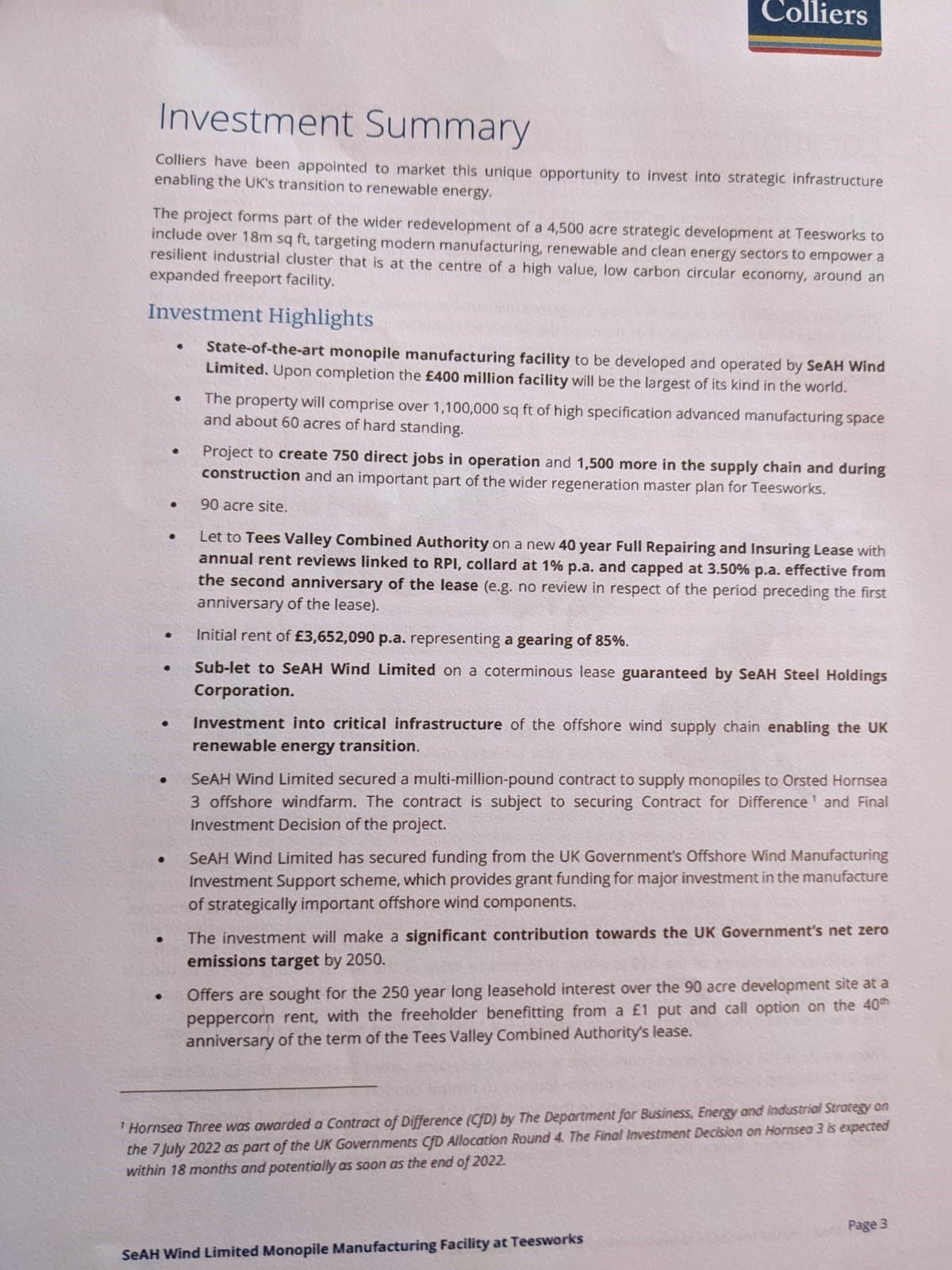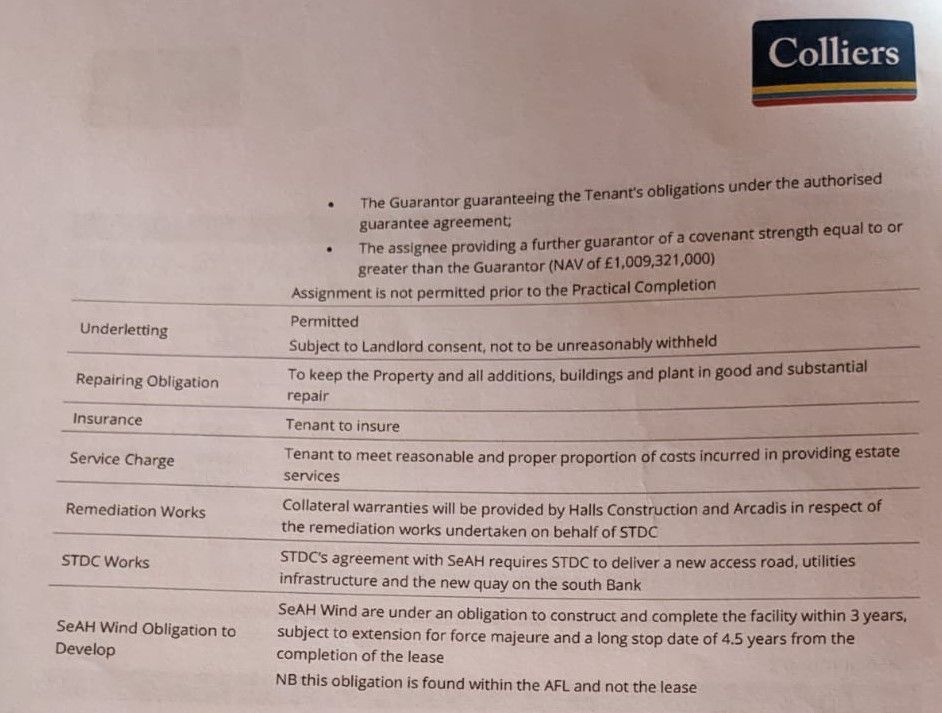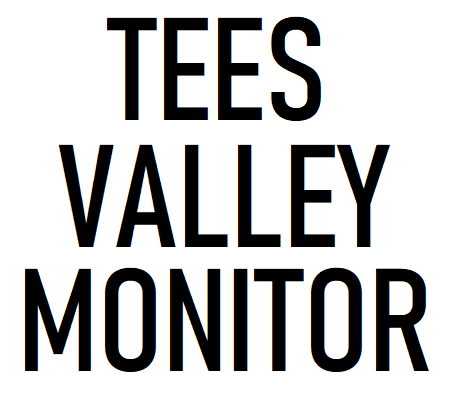3rd Party Submission
of Evidence to the
Teesworks
Corruption Inquiry
17 January 2024
This evidence submission to the independent panel investigating corruption at Teesworks has been obtained by Tees Valley Monitor and is published here with the author’s permission, without attribution. There was an accompanying document with this submission – “Income Strip Funding – Information Memorandum” by estate agents Colliers. Relevant sections from that brochure are appended.
The evidence submission is a detailed account covering the following issues:
The failure of STDC to include Redcar Bulk Terminal (RBT) in the application for compulsory purchase (CPO) of land formerly owned by SSI (the steelworks site).
How this provided developers Corney and Musgrave with an opportunity to influence the outcome of the CPO.
Their acquisition means of acquiring an option on a land parcel on the RBT site.
The lack of transparency by STDC in setting up a joint venture to Corney and Musgrave.
The advantage offered Corney and Musgrave by STDC by allowing them to take option agreements rather than developments on land parcels at Teesworks.
STDC’s under-valuation of land parcels on the Teesworks site.
Corney and Musgrave have not contributed financially to the project.
STDC has not followed best practice by failing to divide the land into bitesize parcels to be developed by a range of different developers.
The inappropriateness of Corney and Musgrave taking a share in the proceeds of scrap sales.
The leasing of land to Australian investors Macquarie is a bad deal for the tax payer.
The inappropriateness of allowing Corney and Musgrave to become the operators of the South Bank Quay rather than give this contract to a specialist operator.
Evidence Document
FURTHER POINTS FOR THE INDEPENDENT REVIEW OF THE SOUTH TEES DEVELOPMENT CORPORATION AND TEESWORKS JOINT VENTURE
Purchase of Site from SSI
The original proposal was for the STDC to buy the entire interest of SSI.
There were 2 parts to the SSI ownership, the main site which came with environmental liabilities and Redcar Bulk Terminal which had positive value.
STDC did a bad deal by buying only the environmental liability but leaving SSI with the valuable Redcar Bulk Terminal.
SSI owned 50% of the Redcar Bulk Terminal and the accounts of Redcar Bulk Terminal show that SSI recently acquired the remaining 50% for around £13 million meaning that it had a total value of £26/27 million.
STDC both the rest of the site with inheriting over £300M remediation costs for £1.00.
If the taxpayer was taking on the remediation liability, in terms of value for money for the taxpayer the Redcar Bulk Terminal interest should have been bought for the same £1.00 helping offset the costs of remediation which the taxpayer was taking on.
This was a bad deal for the taxpayer as it stripped out and took on the liability of the SSI interest but left SSI with the valuable part.
The sale from SSI happened during the compulsory purchase inquiry which was successful. STDC could have obtained the Redcar Bulk Terminal for the same purchase price had it applied value for money principles for the taxpayers investment.
Option of land at Redcar Bulk terminal to Mr Musgrave
Mayor Houchen claims that Mr Musgrave securing an option on land within Redcar Bulk Terminal made STDC grant Mr Musgrave options on the STDC. This does not stack up.
- Redcar Bulk Terminal was within the proposed compulsory purchase order boundary and therefore could have been acquired free from the Option to Mr Musgrave. (Options are not able interests which qualify for compensation payments under compulsory purchase).
- The option which Mr Musgrave held at Redcar Bulk Terminal was only an option for him to pay rent for some land and not to buy anything. If STDC bought the land subject to his option then it would have bought the right for DC Industrial to pay the taxpayer a rent had he exercised the option, not the other way around.
- Mayor Houchen said Mr Musgrave gave up the option with Redcar Bulk Terminal to enable buying the rest of the site. This is not correct as the option to DC Industrial was still shown at the Land Registry as being in place years afterwards.
- The option was signed by Gary O’Malley who then moved from Redcar Bulk Terminal to take a role at Teesworks. This has been reported in Private Eye.
Developer Selection
Public Sector regeneration projects would normally have a transparent developer selection process inviting bids from a variety of prospective purchasers/developers.
This would ensure best value and value for money.
WHY WAS THERE NO TRANSPARENT DEVELOPER SELECTION PROCESS RESULTING IN THE GRANTING OF THE ORIGINAL OPTION AGREEMENTS OVER THE ENTIRE TEESWORKS SITE, AS WELL AS THE AIRPORT?
Private Sector Development Obligations
Public Sector regeneration projects normally select developers and then place legal commitments for the developer to carry out development and invest its own funds with a particular timeframe.
This would be through a Development Agreement which would place obligations to develop within that timescale. If the developer did not comply, then the land would come back to the Public Sector.
WHY WERE MR MUSGRAVE AND MR CORNEY GRANTED OPTION AGREEMENTS RATHER THAN DEVELOPMENT AGREEMENTS?
Option Agreements
An Option Agreement is a contract between a landowner and a prospective buyer that grants the prospective buyer the right to purchase the land within a set period and usually at a set price.
The prospective buyer would normally pay an option fee to secure this control of the landowners land, for the right to lock other potential purchasers out of dealing with the landowner.
The option fee would be in addition to the purchase price payable should the prospective purchaser choose, at its absolute discretion, to exercise the option.
The option period would normally be for a limited period of time so as not to sterilize the land from other development should the holder of the option decide not to exercise the option.
HOW MUCH DID MR MUSGRAVE AND MR CORNEY PAY TO SECURE EXCLUSIVE OPTION AGREEMENTS WITH THE STDC?
HOW LONG WILL THE OPTIONS LAST?
WHAT HAPPENS TO THE LAND IF THEY CHOOSE NOT TO EXERCISE THE OPTIONS AND PURCHASE CERTAIN PARCELS OF LAND?
Valuation of Land Before or After Public Sector Funded Remediation
The STDC land was apparently valued BEFORE remediation at a nominal figure.
If Mr Musgrave and Mr Corney acquired areas of the land at the figure with a defined binding contractual obligation to carry out development including all remediation at their own costs then, that might not be an issue in terms of satisfying public obligations in ‘best value’, as long as the end value of a reclaimed site did not result in excessive ‘super profits’.
Developers would normally expect to generate a profit or return of around 15% on the development costs they incur.
The level of profits generated by Mr Musgrave and Mr Corney appear to be more than the industry norm, with no financial input.
The value they are required to pay for the sites they choose to buy (rather than are obligated to buy) is based upon an overall value BEFORE public sector remediation rather than AFTER public sector remediation.
They may have to repay public sector remediation costs on sites they choose to exercise their options on, this means they are only exercise options on land where the total of the pre-remediation purchase price plus the public sector remediation costs is less than the post remediation value.
This means obtaining an instant profit (post remediation value minus public remediation costs minus option purchase price) for doing nothing other than buying the sites after the taxpayer has paid for everything which generates a profit.
Where the cost of public sector remediation outweighs the end value of a plot they will not exercise the options but still prevent others from controlling the land.
THE GRANTING OF OPTIONS MERELY MEANS THAT MR MUSGRAVE AND CORNEY CAN CHERRY PICK WHAT THEY BUY WHERE IT GIVES THEM AN INSTANT RISK FREE PROFIT, AND LEAVE THE REST OF THE SITE.
Return on Public Investment
Normal public private partnerships would include profits being apportioned based upon the level of financial input by the parties.
If public has put £300M into the site and Mr Musgrave and Mr Corney also put £300M, then a 50/50 split would be fine.
WHAT LEVEL OF FINANCIAL EXPENDITURE HAVE MR MUSGRAVE AND MR CORNEY INCURRED TO ARRIVE AT THEIR PROFITS?
Spreading Risk
Successful public private regeneration projects such as Crown Street, Glasgow involve the public sector selecting a number of different developers for bite size developments, meaning there is no over reliance on only one developer performing.
WHY DID STDC NOT HOLD A TRANSPARENT DEVELOPER SELECTION PROCESS FOR INDIVIDUAL SITES WSHEN MR MUSGRAVE AND MR CORNEY WERE ORIGINALLY APPOINTED ON THE 50/50 JOINT VENTURE?
DID THE TERMS OF THIS 50/50 JOINT VENTURE PREVENT ANY OTHER PUBLIC PROCUREMENT AS THE CONTRACTUAL JOINT VENTURE PARFTNERS HAD PRIORITY OVER SECURING ADDITIONAL SHARES?
Scrap Proceeds
The land and everything on it was acquired by the taxpayer. This included any scrap value.
Mr Musgrave and Mr Corney have only exercised options and bought a small number of sites, such as the TVCA/SeAH site.
WHY SHOULD THEY BENEFIT FROM THE SALE OF TENS OF MILLIONS OF POUNDS OF SCRAP PAID FOR BY THE TAXPAYER?
The SEAH Lease
The SEAH lease is a land lease with SEAH putting its money in to build its building and managing its building contract.
The rent for the land in the first year is £4,296,576, increasing every year.
For 42 months SEAH will not pay any rent.
Teesworks is not building the building, SEAH is.
The SeAH Wind/Tees Valley Combined Authority Investment Sale
STDC employs an engineering team who manage remediation activities and an estates team to manage lettings and disposals.
The lease to SeAH Wind of the 90 acre publicly remediated site should make the taxpayer £4,296,567 a year for 40 years, with annual rent reviews (see enclosed SeAH Wind Income Strip Funding Memorandum from Colliers the estate agents commissioned to sell the income strip). This would be £171,863,040 before compounding interest.
If the letting required the use of an estate agent, the fee would be a small percentage of the first year’s rent.
100% of this annual rent could have been retained by the taxpayer.
According to Private Eye Macquarie is paying £75 million for the right to receive a local government backed income stream. This local government guarantee is outlined in the Colliers brochure as being £3,652,090 per year plus compounding annual interest payments.
The £75 million sale price shows it is being sold for between 20 and 21 times the commencing rent.
Had the taxpayer retained ownership of the land rather than having a 50/50 later to be converted into a 10/90 joint venture with Teesworks, the taxpayer would have retained all of this £75 million from the income strip sale of the local government backed income strip of £3,652,090, plus the taxpayer would have continued to receive £666,486 per year (£4,296,576 per year rent from SEAH minus £3,652,090 guaranteed to Macquarie) for 40 years plus compound interest.
Alternatively, the taxpayer could have raised capital by selling the entire income stream and contractual commitment from SEAH to pay. This could have been over £85,931,520 to the local taxpayer (4,296,576 x 20).
If this SEAH income strip was guaranteed by a local government financial covenant to pay it might be worth a lot more.
All of this value could have been retained by the taxpayer, generating a profit on top of the costs of remediation for that plot.
Instead, the taxpayer is guaranteeing through the sale of an Income Strip to £3,652,090 (85% of the SeAH rent) to a buyer of the investment apparently raising £75 million from Macquarie.
Despite the income Strip relating to land bought and remediated by the taxpayer, the majority of this value goes to Mr Musgrave and Mr Corney through Teesworks.
WHY WAS THIS VALUE ON A SITE BOUGHT AND REMEDIATED BY PUBLIC FINANCE WITH AN INCOME STRIP GUARANTEED BY LOCAL GOVERNMENT AND ULTIMATELY THE TAXPAYER NOT ENTIRELY RETAINED BY THE LOCAL TAXPAYER?
WHAT HAD MR CORNEY AND MR MUSGRAVE DONE TO DERIVE THEIR SHARE OF THIS VALUE?
IF SEAH DOES NOT PAY RENT (IN ADDITION TO THE 42 MONTHS WHERE IS DOES NOT DO SO IN THE LEASE), OR SHUTS DOWN, THE LOCAL TAXPAYER (TEES VALLEY COMBINED AUTHORITY) STILL HAS TO GUARANTEE MACQUARIE £3,652,090 PLUS COMPOUNDING INTEREST EVERY YEAR.
IF THE FIGURE IN THE PRESS OF £75 MILLION FOR THE OBLIGATION FOR THE TAXPAYER TO BANKROLL THE PAYMENT OF £3,652,090 PER YEAR FOR 40 YEARS THEN THE 375 MILLION PRICE IF OBTAINED THROUGH A PROPER MARKETING/PROCUREMENT IS NOT THE ISSUE. THE ISSUES ARE –
WHO MADE THE DECISION TO COMMIT THE TAXPAYER TO PAY £146,083,600 (BEFORE COMPOUNDING INTEREST PAYMENTS) TO MACQUARIE OR ANYONE ELSE MAY HAVE BOUGHT THAT INCOME STRIP?
WHY WAS THE SECURITY OF A LOCAL GOVERNMENT FINANCIAL COVENANT GIVEN TO SECURE A PRICE (£75 MILLION) OF WHICH THE MAJORITY OF THE VALUE WILL GO TO PRIVATE SECTOR INDIVIDUALS?
South Bank Quay
The taxpayer has borrowed over £107M to build this new quay.
IF AN OPTION TO BUY THE QUAY WAS TO BE GRANTED RATHER THAN THE TAXPAYER RETAIN CONTROL OF A DEVELOPMENT IT HAS FUNDED, WHY WAS THIS NOT SOLD OR LEASED BY STDC TO A SPECIALIST QUAY OPERATOR RATHER THAN TO MR MUSGRAVE AND MR CORNEY?
Excerpts from "Income Strip Funding Information Memorandum" by estate agents Colliers



